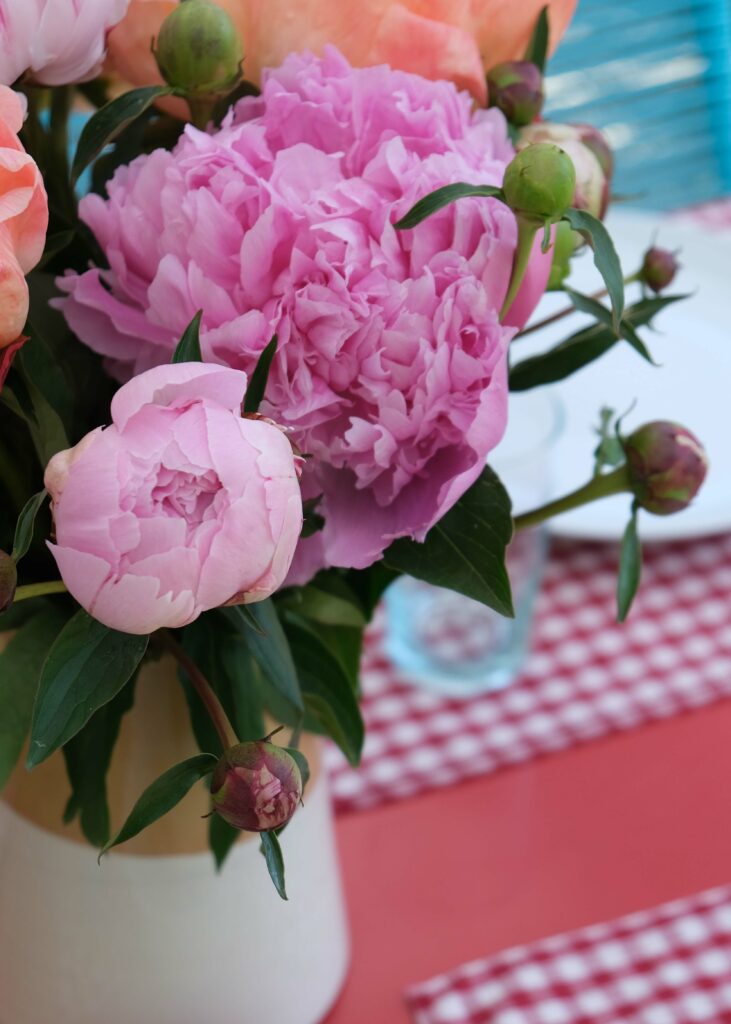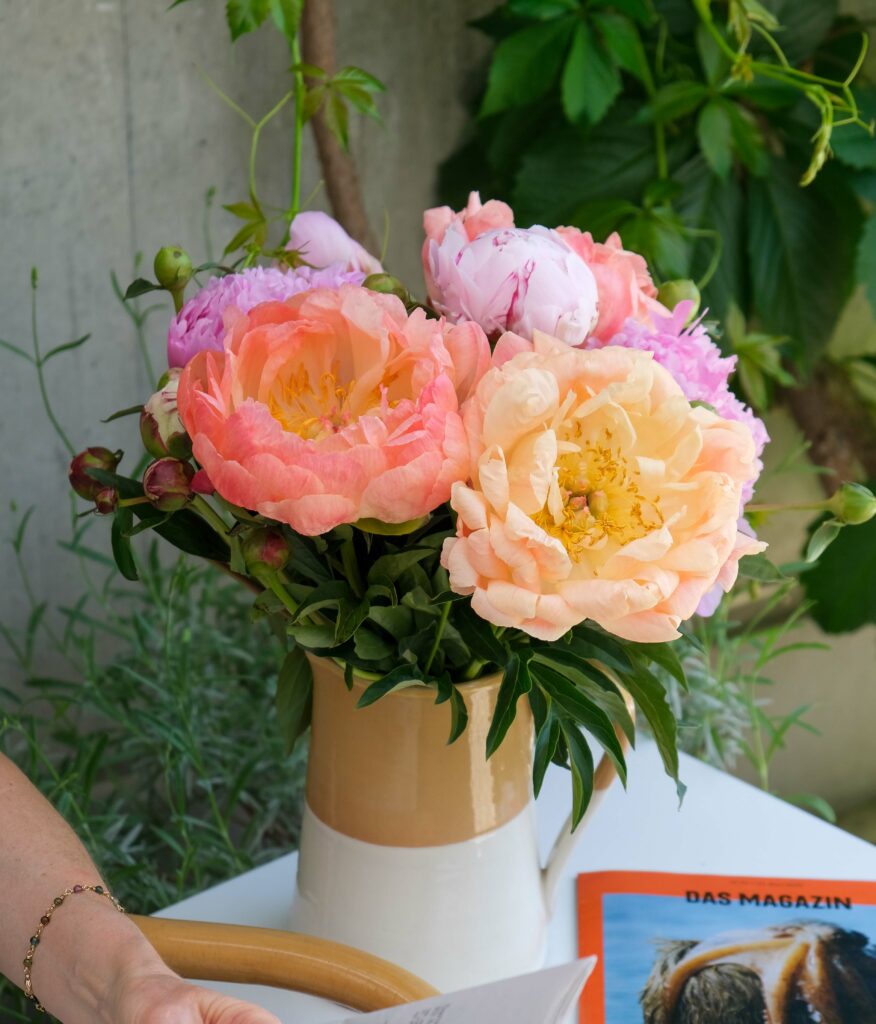With their abundant splendour of petals ranging from warm white to deep wine red, peonies are probably among the most beautiful flowers in Switzerland. But what varieties are there? And how do you care for them properly so that they bloom in full splendour? You can find out all this and more in this blog article.
What peony varieties are there?
Peonies come in many colours – after all, there are over 3000 varieties worldwide! In the beautiful bouquets from our producer Blumenpost, you will find the following two species in particular:

- Coral Sunset: This peony is almost magical! For while its flowers glow from coral to pink shortly after opening, they change colour as they flower! This happens from day to day until they finally turn pastel yellow. The Coral Sunset is therefore particularly suitable as a (Mother’s Day) gift, as it offers variety and surprise. You could almost think that there is a different flower in the vase every day.
- Sarah Bernardt: This peony variety blooms in deep pink. Victor Lemoine, a famous peony expert, bred it in 1906 in honour of the (French) actress of the 19th century. It delights not only with its elegance, but also thanks to its flowery, rosy fragrance.

In general, a distinction is made between perennial peonies and bush peonies. The former disappear completely underground in winter. They are popular because of their robustness and are therefore common in many gardens.
Bush peonies are characterised by their – as the name already suggests – bushy growth. Unlike the perennial peonies, they lose their leaves in winter but remain above ground.
There are also hybrid varieties in which two species are crossed.
What symbolism does the peony carry?
As its name suggests, the peony, like the rose, generally stands for love. However, depending on the culture, it is also associated with other symbols.
In China, for example, it stands for luck and wealth. In Christianity, it symbolises motherly love, security and salvation. That’s why you’ll also find it in our Mother’s Day bouquets. Here it is also known under the names “Rose without thorns” and “Marian flower”.
Peonies in medicine
Did you know that the peony was also used in medicine? In ancient times it was used to combat rheumatism (which is why it is also known as the “gout rose”), stomach complaints, cramps and inner restlessness.
In fact, peonies contain antioxidants in the form of anthocyanins as well as flavonoids, which are supposed to reduce inflammation and have an antibacterial effect.
And yet, over time, the peony disappeared in medicine – especially in Europe. The reason for this: scientific proof of its effectiveness could not be confirmed. Moreover, peonies are slightly poisonous! So you’d better only use them as decoration.
How to properly care for your peonies
Peonies are relatively easy to care for because of their robustness. If you follow our tips & tricks, you can enjoy them for a long time.
Peonies in the garden
Peonies are hardy! After planting them in a bed – they are not suitable for planters – you can safely leave them in their place. Only withered shoots should be removed directly above the ground in late autumn.
Regarding the suitable location, you should consider the following:
- With an average of 15 cm per flower head, peonies love the sun.
- Your peony will do best in a humusy, loamy sandy soil.
- Plant at a distance of about 80 cm from other plants. White foxglove or blue forget-me-nots are particularly good neighbours.
- Do not plant too deep! 3 to 5 cm is sufficient.
The following is further important for care:
- Protect with a perennial ring in case of rain so that their flowers do not break.
- Avoid waterlogging at all costs! It is best to water regularly, but only a little.
- If possible, do not relocate. The peony needs 2 to 3 years to flower again after having been moved.

If you want to take some of your peonies indoors as cut flowers, these tips are also particularly valuable:
- You should wait 3 to 4 years after planting before cutting cut flowers.
- Cut when the flowers are still closed but have already taken on colour. The heads should no longer be hard and should give a little when you squeeze them lightly with your fingers.
- Cut off a maximum of ⅓ of the entire plant! The rest is needed for photosynthesis. You may risk fewer flowers the following year otherwise!
Tip: Let ants get to your peonies!
The peony is usually most pleasing when it is in full bloom. But did you know that the sugar juice it produces can glue its petals together? This is secreted by the finest hairs while the leaves are still closed. That’s why it’s important to let ants get to your peonies! They eat the sugar juice; your peonies open up.
Peonies as cut flowers
Whether you’ve bought peonies or picked your own from the garden, check out these tips for caring for cut flowers!
Especially with peonies, you should also make sure that you arrange them individually in the vase, as their stems are very sensitive to pressure. In this way you also give their heads more space to blossom – which they definitely need!
In general rule, peonies wilt after about 5 days. Then they drop their flowers elegantly. If only one flower wilts, you can try this trick:
- Cut freshly wilted peony.
- Boil water and pour into a fresh vase.
- Place the peony into the vase.
After about 2 hours your peony will shine fresh! It’s best to leave those peonies individually in their vase. This way they can spread joy in another room, for example in the bathroom or on the bedside table.











What do you think?